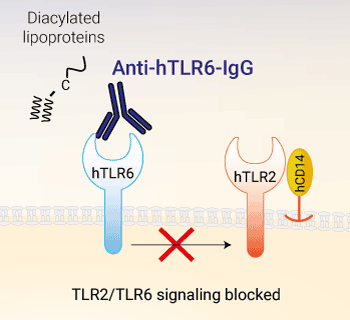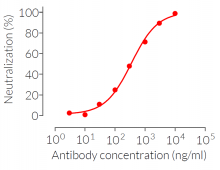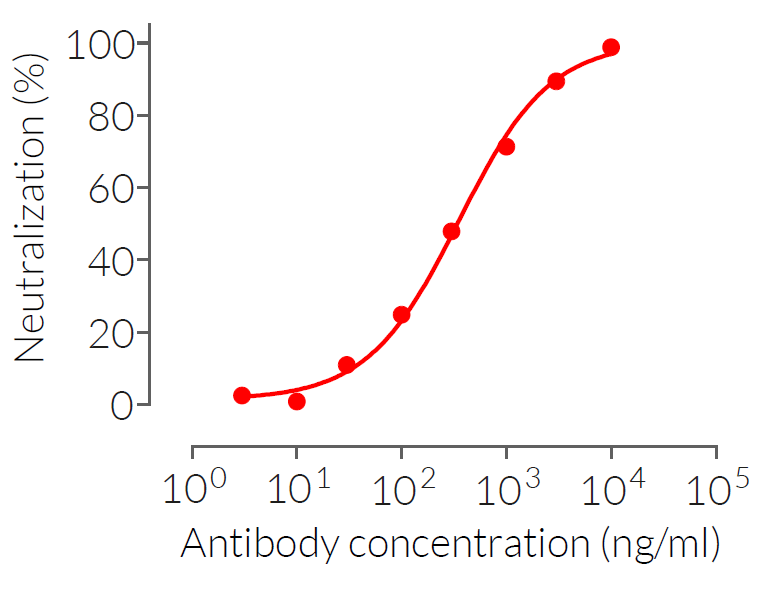Anti-hTLR6 Neutralizing mAb
| Product | Unit size | Cat. code | Docs. | Qty. | Price | |
|---|---|---|---|---|---|---|
|
Anti-hTLR6-IgG Human TLR6 Neutralizing antibody (clone C5C8) - Monoclonal Mouse IgG1 |
Show product |
2 x 100 µg |
mabg-htlr6-2
|
|
Human TLR6 Neutralizing antibody - Monoclonal Mouse IgG1 (C5C8)

Neutralizing monoclonal antibody against human TLR6
Anti-hTLR6-IgG (clone C5C8) is a monoclonal antibody specific for human Toll-like receptor 6 (hTLR6, CD286). This antibody can be used for the neutralization of hTLR6, it blocks cellular activation induced by agonists that are recognized by TLR6 and TLR2, such as FSL-1. It is produced in hybridoma cells and purified by affinity chromatography.
TLR6 co-operates with TLR2 to recognize diacylated lipoproteins (LPs) found in mycoplasma but is not required in the recognition of triacylated LPs found in bacteria [1, 2]. This suggests that TLR6 is able to discriminate between the N- terminal lipoylated structures of LPs derived from mycoplasma and bacteria. TLR6 collaboration with TLR2 is essential for the recognition and signal transduction of diacylated LPs, such as MALP- 2 and FSL-1 [2, 3], as well as heat-killed mycoplasma, indicating that TLR6 and TLR2 play a central role in recognizing mycoplasma [2].
Key features:
- Reacts with human TLR6
- Provided azide-free
- Each lot is functionally tested
![]() Read our review on Toll-Like Receptors.
Read our review on Toll-Like Receptors.
References
1. Takeuchi O. et al., 1999. TLR6: A novel member of an expanding toll-like receptor family. Gene. 231(1-2):59-65.
2. Takeuchi O. et al., 2001. Discrimination of bacterial lipoproteins by Toll-like receptor 6. Int Immunol, 13(7):933-40.
3. Fujita M. et al., 2003. Involvement of leucine residues at positions 107, 112, and 115 in a leucine-rich repeat motif of human Toll-like receptor 2 in the recognition of diacylated lipoproteins and lipopeptides and Staphylococcus aureus peptidoglycans. J Immunol. 171(7):3675-83.
Specifications
Clonality: Monoclonal antibody
Specificity: Human TLR6
Clone: C5C8
Isotype: Mouse IgG1, kappa
Control: Mouse Control IgG1
Source: Hybridoma cells
Formulation: 0.2 µm filtered solution in a sodium phosphate buffer with glycine, saccharose, and stabilizing agents
Applications: Neutralizing human TLR6-induced cellular activation
Quality control:
- The biological activity has been validated using cellular assays.
- The absence of bacterial contamination (e.g. lipoproteins and endotoxins) has been confirmed using HEK-Blue™ TLR2 and HEK‑Blue™ TLR4 cells.
Contents
- 2 x 100 µg purified monoclonal anti-hTLR6 IgG antibody provided lyophilized.
![]() Product is shipped at room temperature.
Product is shipped at room temperature.
![]() Upon receipt, store lyophilized antibody at -20°C.
Upon receipt, store lyophilized antibody at -20°C.
Back to the top
Details
Toll-like receptors (TLRs) play a critical role in early innate immunity to invading pathogens by sensing microorganisms. These evolutionary conserved receptors recognize highly conserved structural motifs only expressed by microbial pathogens, called pathogen-associated microbial patterns (PAMPs). Stimulation of TLRs by PAMPs initiates a signaling cascade leading to the secretion of proinflammatory cytokines following NF-κB activation. To date ten human and twelve murine TLRs have been characterized, TLR1 to TLR10 in humans, and TLR1 to TLR9, TLR11, TLR12 (aka TLR11) and TLR13 in mice, the homolog of TLR10 being a pseudogene.
TLR6, which is closely related to TLR1, is expressed predominantly in spleen, thymus, ovary and lung [1]. TLR6 cooperates with TLR2 to recognize diacylated lipoproteins (LPs) found in mycoplasma but is not required in the recognition of triacylated LPs found in bacteria [2]. This suggests that TLR6 is able to discriminate between the N-terminal lipoylated structures of LPs derived from mycoplasma and bacteria. TLR6 collaboration with TLR2 is essential for the recognition and signal transduction of diacylated LPs, such as MALP-2 and FSL-1 [2, 3], as well as heat-killed mycoplasma, indicating that TLR6 and TLR2 play a central role in recognizing mycoplasma [2].
1. Takeuchi O. et al., 1999. TLR6: A novel member of an expanding toll-like receptor family. Gene. 231(1-2):59-65.
2. Takeuchi O. et al., 2001. Discrimination of bacterial lipoproteins by Toll-like receptor 6. Int Immunol, 13(7):933-40.
3. Fujita M. et al., 2003. Involvement of leucine residues at positions 107, 112, and 115 in a leucine-rich repeat motif of human Toll-like receptor 2 in the recognition of diacylated lipoproteins and lipopeptides and Staphylococcus aureus peptidoglycans. J Immunol. 171(7):3675-83.






